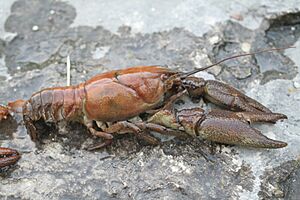White-clawed crayfish facts for kids
Quick facts for kids White-clawed crayfish |
|
|---|---|
 |
|
| Conservation status | |
| Scientific classification | |
| Synonyms | |
|
The White-clawed crayfish (scientific name: Austropotamobius pallipes) is a special type of freshwater crayfish. It lives in Europe and is the only crayfish naturally found in the British Isles. This amazing creature is an endangered species, which means it is at risk of disappearing. People also call it the Atlantic stream crayfish.
Contents
Where Do White-Clawed Crayfish Live?
White-clawed crayfish live across a wide area in Europe. You can find them from the Balkan Peninsula in the east all the way to Spain. Their northernmost home is in Great Britain. They also live in Ireland, but they were brought there by people.
In these places, they prefer certain areas. They are most common in "chalk streams," which are rivers with clear water flowing over chalky ground. In Ireland, they are the only crayfish species found. They live in rivers, streams, canals, and lakes, especially where there is limestone. In France, they are a protected species. They have also been introduced to places like Corsica and Liechtenstein.
Sadly, the number of White-clawed crayfish in Great Britain is shrinking fast. They used to be found almost everywhere. Now, they are only in certain parts of Yorkshire and central England. You can also find them in eastern Wales and some rivers like the River Thames.
What is Their Habitat Like?
White-clawed crayfish do not like very acidic water. They prefer streams with a gentle flow. They share their homes with other freshwater animals. These include caddis fly larvae, mayfly larvae, and different types of molluscs. Fish like trout and three-spined stickleback also live in the same places.
These crayfish need good hiding spots. They often hide among tree roots and rocks along the riverbanks. Young crayfish, called juveniles, find shelter in plants. They like to hide in watercress and thick grass growing out of the bank.
What Do White-Clawed Crayfish Look Like?
The White-clawed crayfish is usually olive-brown in color. The underside of its claws is pale, which is how it got its name "pallipes," meaning "pale feet" in Latin.
These crayfish can grow up to about 12 centimeters (almost 5 inches) long. However, it's more common to see adults that are less than 10 centimeters (about 4 inches) long. They typically live in rivers and streams that are about 1 meter (3 feet) deep. They hide among rocks and sunken logs. At night, they come out to search for food. They also live in lakes.
Why Are White-Clawed Crayfish Endangered?
There are two main reasons why White-clawed crayfish numbers are going down:
- New Species Arriving: Other types of crayfish have been brought into their habitats. The most harmful is the North American signal crayfish. This crayfish carries a disease called "crayfish plague." Signal crayfish are not affected by this disease, but White-clawed crayfish have no protection against it. When the plague spreads, it can wipe out whole groups of White-clawed crayfish. Another introduced species, the red swamp crayfish, also causes problems.
- Water Pollution: Many local groups of White-clawed crayfish have disappeared because of dirty water. This pollution comes from different sources. It can be from insecticides used on farms that wash into rivers. It can also be from dirty water that has not been cleaned properly. Sometimes, illegal wastewater is dumped into rivers, which is very harmful to the crayfish.


